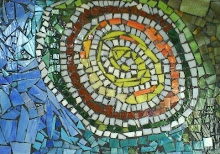 I had given in to a severe weeklong bout of fever; and while the body was burning with blistering viruses; my mind was creating shaky drawings on a paper. Thanks to Paracetamol and delirium, these drawings became backgrounds for many webpages, for months and years to follow.
I had given in to a severe weeklong bout of fever; and while the body was burning with blistering viruses; my mind was creating shaky drawings on a paper. Thanks to Paracetamol and delirium, these drawings became backgrounds for many webpages, for months and years to follow.Rangoli--A popular North-Indian 'folk-art'; it is a form of sandpainting decoration that uses finely ground white and coloured powders (including indigo-- fabric dye and spices like turmeric, chili, rawa, rice flour, and wheat flour), and is commonly done outside homes in India.
The term rangoli is derived from the words rang (colour) and aavalli ('coloured creepers' or 'row of colours').
The term rangoli is derived from the words rang (colour) and aavalli ('coloured creepers' or 'row of colours').
The concept of design here includes one important point --the entire pattern must be an unbroken line, with no gaps to be left anywhere for evil spirits to enter. The popularity rangoli has spread all over the Indian sub-continent over the years and so has the meaning, what was an entry-point of 'goodness', 'luck' and 'prosperity' for the household has grown into an ostentatious welcome and entry-point for all guests or atithi to the house.
For me, personally, geometric designs such as these carry a deep meaning of balance and outrage concurrently.And there is something about the famous 'hens and chickens' structure that I can not get over with.

No comments:
Post a Comment